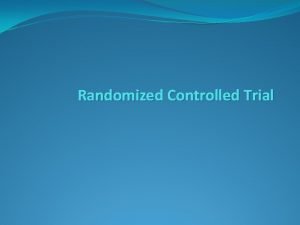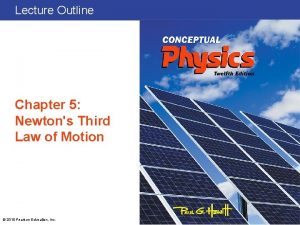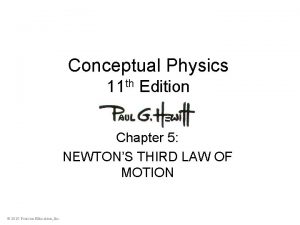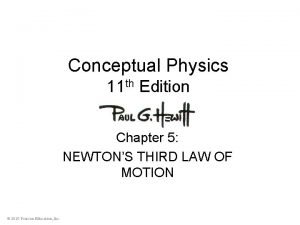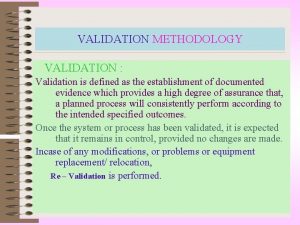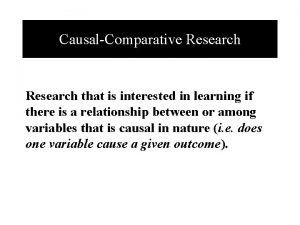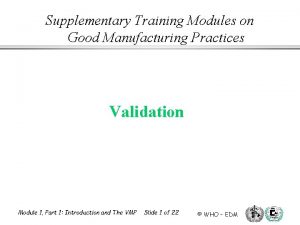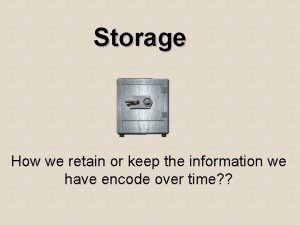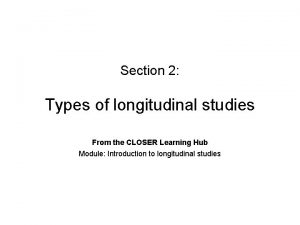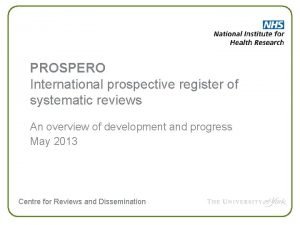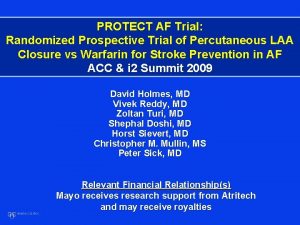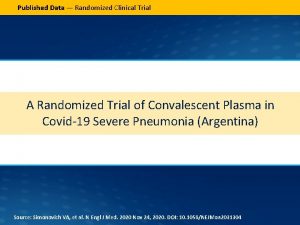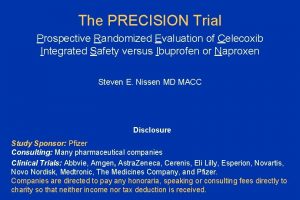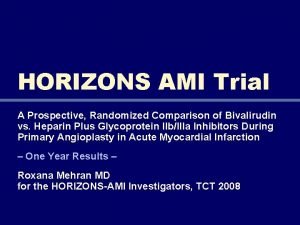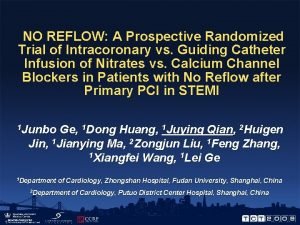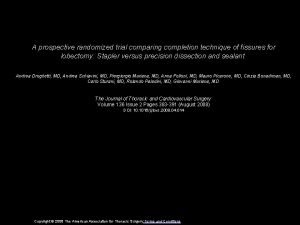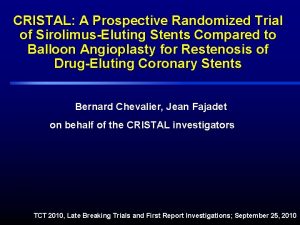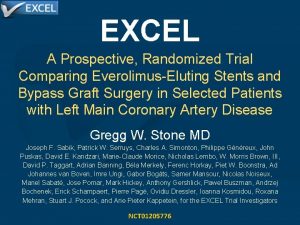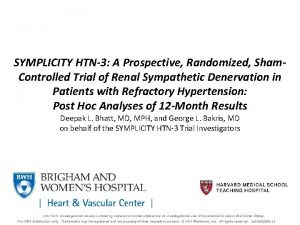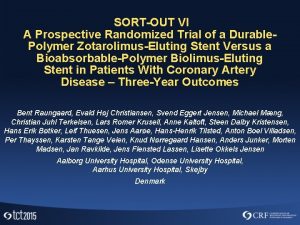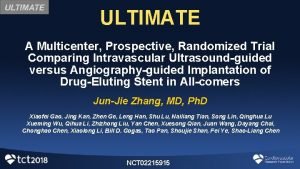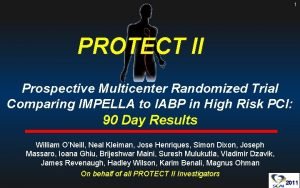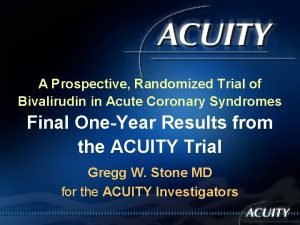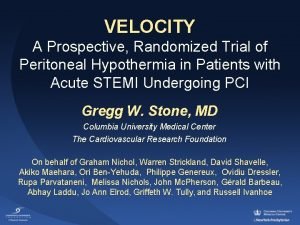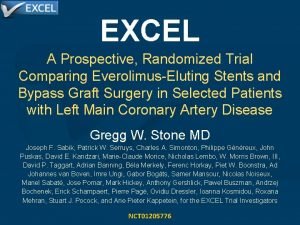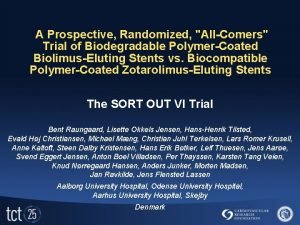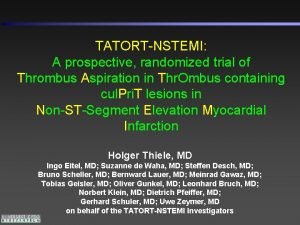The DEFLECT III Trial A Prospective Randomized Evaluation
























- Slides: 24

The DEFLECT III Trial: A Prospective Randomized Evaluation of the Tri. Guard. TM HDH Embolic DEFLECTion Device during Transcatheter Aortic Valve Implantation Alexandra Lansky, MD Yale University School of Medicine University College London

Clinical Stroke after TAVI 30 -day stroke rates Leon et al. NEJM. 2010; 363: 1597, Smith et al. NEJM. 2011; 364: 2187, Adams et al. NEJM 2014; 370: 1790, Leon MB ACC 2013, Popma et al. JACC 2014; 63: 1872, Eggebrecht et al. Euro. Intervention. 2012; 8: 129, Messe et al. Circulation 2014; 129: 2253, Tchetche et al. JACC Cardiovasc Interv 2014; 7: 1138, Miller et al. J Thorac Cardiovasc Surg 2012; 143: 832 • 4 -7% at 30 days in RCTs • Generally under-reported (17% after SAVR when evaluated by neurologist) • Confer 3 - to 9 -fold increased risk of mortality • 50% are peri-procedural

Silent Embolic Events on DW-MRI after TAVI % of Subjects with New Lesions • Affect 58 -93% of subjects • Multiple infarcts (≤ 36, x = 4. 6) • Associated with: § Neurocognitive decline § >2 fold risk of dementia § >3 fold risk of stroke Restrepo et al. Stroke 2002; 33: 2909, Lund et al. Eur Heart J. 2005; 26: 1269, Schwarz et al. Am Heart J 2011; 162: 756, Knipp et al. Ann Thorac Surg 2008; 85: 872, Vermeer et al. NEJM 2003; 348: 1215, Vermeer et al. Stroke 2003; 34: 1126, Arnold et al. JACC Cardiovasc Interv. 2010; 3: 1126, Astarci et al. J Heart Valve Dis. 2013; 22: 79, Fairbairn et al. Heart 2012; 98: 18, Ghanem et al. Euro. Intervention. 2013; 8: 1296, Kahlert et al. Circ. 2010; 121: 870, Knipp et al. Interact Cardiovasc Thorac Surg. 2013; 16: 116

The Tri. Guard™ HDH Device • Nitinol single-wire frame and mesh filter with pore size of 130μm designed to deflect cerebral emboli while allowing maximal blood flow • Device is positioned across all 3 cerebral vessels and maintained by a stabilizer in the innominate • Delivered via 9 Fr sheath from femoral artery

Tri. Guard Clinical Program Study Description N (Tri. Guard) First in Human Single center (NL) 15 Complete DEFLECT I Prospective multicenter (EU) 37 Complete – CE Mark received in 2014 DEFLECT II Single center (NL) 12 Complete DEFLECT III RCT (EU/IL) 45 30 -day follow up ongoing REFLECT Pivotal IDE Trial (US + EU) TBD Status IDE Approved – first subject in 2015

DEFLECT III Study Overview Design: Prospective single-blind randomized controlled trial at 12 sites (EU/IL) Objective: To evaluate the safety, efficacy and performance of Tri. Guard HDH embolic protection compared with unprotected TAVI. Sample Size: No formal hypothesis testing. Up to 86 subjects (43 per group) selected to provide safety and efficacy benchmarks for the design of a pivotal RCT. Subjects with AS undergoing TAVI (TF or TA access) 1: 1 Randomization Embolic Protection (Tri. Guard HDH) Unprotected TAVI (Control) Primary Endpoint: In-hospital MACCE defined as the composite of death, stroke, life-threatening or disabling bleeding, AKI (2/3), and major vascular complications

DEFLECT III Procedures & Assessments Screening Post-Procedure 4± 2 days NIHSS m. RS Neurocog* TAVI ± Tri. Guard 30 days DW-MRI NIHSS m. RS Neurocog* *Neurocognitive test battery includes the Montreal Cognitive Assessment (Mo. CA) and computerized Cog. State Research Test. Baseline and 30 -day evaluations include supplemental Digit Symbol Substitution, Trailmaking, and Word Fluency Tests.

DEFLECT III Eligibility Criteria • Key Inclusion Criteria § Planned to undergo TAVI via the transfemoral or transapical approach • Exclusion Criteria § Other TAVI approaches (axillary, subclavian, direct aortic) § Stroke or TIA within prior 6 months § Anatomic irregularities of the aortic arch or innominate artery that could prevent positioning and stability of the device (ostium diameter <11 mm, transverse aortic diameter >40 mm) § Contraindication to cerebral MRI (e. g. , pacemaker) § Any other cardiac intervention within prior 2 weeks

DEFLECT III Key Secondary Endpoints • Safety § TAVI device success (VARC-2) in-hospital § TAVI early safety (VARC-2) at 30 days § Components: death (CV/non-CV), MI, neurological events, bleeding complications, AKI, vascular complications • Efficacy § DW-MRI: Frequency, number, and per-patient average single, maximal single, and total volume of DW-MRI lesions at 4+2 days (range 2 -6 days) § Neurocognitive: Postoperative cognitive function, change in cognitive function from baseline to postprocedure and 30 days • Performance § Technical success: successful device deployment, positioning (3 -vessel coverage verified by angiography), and retrieval without interference with TAVI

DEFLECT III Statistical Analysis Plan • Exploratory analysis - no formal hypothesis testing was planned. • Endpoints analysis: • Primary endpoint (safety): In-hospital procedural safety (Hierarchical composite) evaluated in the Intention to Treat (ITT) analysis population • Efficacy endpoints: • Non-parametric analysis (DW-MRI volumetric data is non -normally distributed) • ITT population • Per treatment (PT) population: excludes subjects with incomplete Tri. Guard cerebral vessel coverage (core lab adjudicated)

DEFLECT III Trial Organization Coordinating Principal Investigators Alexandra Lansky, MD MRI Core Lab Szilard Voros (Director) Yale University School of Medicine, USA Andreas Baumbach, MD Bristol Heart Institute, UK Global Institute for Research, Richmond, VA, USA Angiographic Core Lab Biostatistic Alexandra Lansky (Director) Neurocognitive Assessment Adam Brickman (Director) Helen Parise (Statistics) Yale University School of Medicine, New Haven, CT, USA Columbia University, New York, USA Clinical Events Committee Michael Cleman, MD (Chair) John Forrest, MD Monitoring, Site Mgmt. Data Mgmt Genae International, Inc. Harvard Clinical Research Institute Joseph Brennan, MD Abeel Mangi, MD Yale University School of Medicine, New Haven, CT, USA

DEFLECT III Trial – Enrollment Highlights Feb 26, 2014 Feb 24, 2015 March 24, 2015 Enrollment Start RCT Enrollment Complete 30 day FU Complete 5 Countries / 12 Centers Joachim Schofer (17) Andreas Baumbach (8) Med Spitzer (2) Bristol, United Kingdom Dresden, Germany Didier Tchetche (13) Pieter Stella (9) Martine Gilard (2) Utrecht, Netherlands Brest, France Christophe Bode (10) Daniel Blackman (6) Michael Haude (1) Leeds, United Kingdom Neuss, Germany Thomas Cuisset (10) Gil Bolotin (4) David Hildick-Smith (1) Hamburg, Germany Toulouse, France Frieburg, Germany Marseille, France Haifa, Israel Brighton, United Kingdom

DEFLECT III Patient Disposition Intent To Treat Population N=83 Embolic Protection (Tri. Guard HDH) n = 45 MRI Loss to FU • Stroke n=1 • Withdrawn/refused n = 3 • PPM n=9 In-hospital FU Safety n = 45 DW-MRI: n = 32 (ITT), n = 26 (PT) Unprotected TAVI (Control) n = 38 MRI Loss to FU • Death n = 3 • Stroke/PPM n=1 • Withdrawn/refused n = 4 • PPM n=6 In-hospital FU Safety n = 38 DW-MRI: n = 24 (ITT), n = 24 (PT)

Baseline Clinical Characteristics Tri. Guard HDH N=45 Controls N=38 P value 82. 7 ± 6. 5 40. 9% 4. 7 10. 1 82. 5 ± 5. 9 50. 0% 7. 4 0. 62 0. 41 0. 48 0. 66 83. 3% 45. 0% 25. 0% 31. 8% 6. 8% 78. 9% 37. 8% 44. 7% 26. 3% 32. 4% 0. 0% 0. 65 0. 85 0. 06 0. 89 0. 95 0. 10 Previous stroke/TIA 14. 0% 18. 4% 0. 58 Frailty Porcelain Aorta 11. 9% 4. 5% 18. 4% 0. 0% 0. 42 0. 18 ITT population Age (y) ± SD Male STS Score Euro. SCORE II NYHA Class I or II (%) III or IV (%) Atrial Fibrillation CKD COPD O 2 Dependent

Procedure Details ITT population General Anesthesia Valvuloplasty Pre-TAVI Implants Core. Valve Edwards Sapien/3/XT Other* Total Fluoro time (min) Total Contrast time (min) Adjunct Pharmacology ASA + clopidogrel ASA only Clopidogrel only Warfarin Tri. Guard HDH N=45 Controls N=38 76. 7% 61. 1% n=44 31. 8% 63. 6% 2. 3%* 28. 2 165. 8 76. 3% 70. 4% n=37 26. 3% 65. 8% 5. 3%** 18. 6 138. 6 0. 59 0. 84 0. 47 <0. 001 0. 16 69% 16. 7% 11. 9% 67. 6% 16. 2% 8. 1% 18. 9% 0. 89 0. 96 0. 58 0. 39 *Direct Flow; **Lotus Valve P value 0. 96 0. 45

Device Performance ITT population Technical success (composite): Successful deployment Successful positioning (complete 3 -vessel coverage until final valve deployment of first valve, verified by QCA) Successful retrieval Device interference (with TAVI system) Device Failure *One subjects had 2 Tri. Guard HDH devices used Tri. Guard HDH % (n/N) N=46 devices* 95% CI 87 (40/46) 93. 5 (43/46) [68. 6, 92. 2] [82. 1, 98. 6] 87. 0 (40/46) [73. 7, 95. 1] 97. 8 (45/46) 0 (0/46) 0% (0/46) [88. 5, 99. 9] [0. 0, 7. 7] [0. 1, 11. 5]

In-hospital Safety Outcomes (ITT) ITT population Hierarchical Composite In-hospital MACCE Death All stroke Life-threatening bleed AKI (Stage 2/3) Major vascular comp. Tri. Guard HDH % (n/N) Controls % (n/N) Relative Risk [95% CI] 22. 2 (10/45) 31. 6 (12/38) 0. 70 [0. 34, 1. 45] 2. 2 (1/45) 15. 6 (7/45) 5. 3 (2/38) 0 (0/38) 15. 8 (6/38) 0. 42 [0. 04, 4. 48] 2. 54 [0. 11, 60. 7] 0. 99 [0. 36, 2. 68] 2. 2 (1/45) 4. 4 (2/45) 2. 2 (1/45) 17. 8 (8/45) 5. 3 (2/38) 7. 9 (3/38) 0 [0, 38] 21. 1 (8/38) 0. 42 [0. 04, 4. 48] 0. 84 [0. 12, 5. 71] 0. 28 [0. 03, 2. 60] 2. 54 [0. 11, 60. 7] 0. 84 [0. 35, 2. 04] 97. 8 (44/45) 94. 7 (36/38) 1. 03 [0. 95, 1. 13] Non-hierarchical components Death All stroke Life-threatening bleed AKI (Stage 2/3) Major vascular comp. TAVI Device Success (VARC 2 Composite)

DW-MRI Results – Frequency and Number Lesion Volume (mm 3) Frequency and Number of New Lesions by Treatment Group (PT population)

DW-MRI Results – Single and Max Lesion Volume (mm 3) Median Per-Patient Single and Maximum Lesion Volumes 45% 17% 16% Intention to Treat 41% Per Treatment

DW-MRI Results – Zero Total Lesion Volume Proportion of Subjects with Zero Total Lesion Volume

Efficacy Outcomes – Discharge NIHSS Proportion of Subjects with and without a net NIHSS decrement from baseline to discharge (ITT population)

Mo. CA Score – Trends (ITT) On average, Mo. CA scores improved in the Tri. Guard arm and decreased in the control arm MOCA at Discharge % Same/improved

Cog. State-Test Results (PT) Visual learning and short term memory test Treatment X Time interaction, p=0. 043 Delayed memory test Treatment X Time interaction, p=0. 028

Conclusions • DEFLECT III is the first multicenter randomized clinical trial of neuroprotection (non-powered) designed to explore safety and novel neurocognitive and DW-MRI surrogate efficacy endpoints • Loss to DW-MRI was high (35%) and loss to NC evaluation was 17% from baseline to post procedure • Use of the Tri. Guard HDH device was safe and provided complete cerebral coverage in 87% of cases. • Neurocognitive function, based on novel measures used, appear to improve from baseline to discharge • The prevalence of DW-MRI lesions was numerically lower in patients treated with the Tri. Guard device, and subjects in whom the device was properly positioned may be protected from the largest lesions. • DEFLECT III will benchmark event rates for a future randomized trial that will be able to truly examine the potential benefits of the Tri. Guard device
 Advantage of randomized controlled trial
Advantage of randomized controlled trial A building bent deflects in the way same as a
A building bent deflects in the way same as a Chapter 5 newton's third law of motion
Chapter 5 newton's third law of motion Slightly tilted wings of airplanes deflect
Slightly tilted wings of airplanes deflect Conceptual physics chapter 5 newton's third law of motion
Conceptual physics chapter 5 newton's third law of motion Hamlet act iii scene iii
Hamlet act iii scene iii Iceberg phenomenon definition
Iceberg phenomenon definition Retrospective cohort study vs prospective cohort study
Retrospective cohort study vs prospective cohort study Prospective validation
Prospective validation Institute for prospective technological studies
Institute for prospective technological studies Retrospective validation
Retrospective validation Retrospective causal-comparative research
Retrospective causal-comparative research Prospective memory examples
Prospective memory examples Validation definition
Validation definition Prospective goals definition
Prospective goals definition Prospective-glass
Prospective-glass Veille prospective
Veille prospective Longitudinal research design example
Longitudinal research design example Prospective memory psychology definition
Prospective memory psychology definition Difference between case control and cohort study
Difference between case control and cohort study Prospective analysis financial statements
Prospective analysis financial statements Types of longitudinal studies
Types of longitudinal studies Prospero systematic review
Prospero systematic review What is case series
What is case series Validation definition
Validation definition
